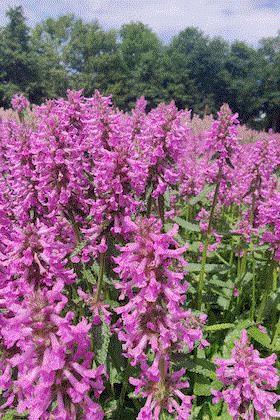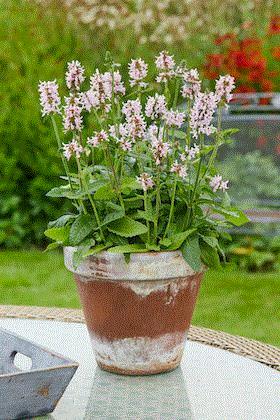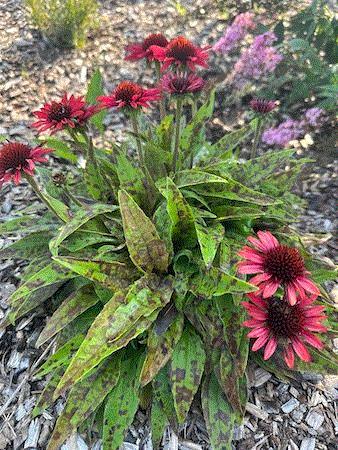What’s Happening Here?
Wow, it's already August. I hope you're having a great summer so far. Let's start the month off with a diagnaostic challenge. I came across a peculiar looking echinacea in my landscape this past weekend:
Don’t get me wrong, I’ve seen similar appearances on other perennials, as I suspect you have too, but not on echinacea. I guess you could say this appearance is both peculiar and familiar to me.
This issue has been known to occur on echinacea, but I’ve been fortunate enough to not have experienced it before and thank goodness this isn’t currently occurring on one of my crops. Besides its appearance, I found it peculiar that only one plant was showing symptoms and there were other echinacea within 3 ft. of this one.
It’s time for me to ask, "What’s happening here?" If you already know what’s going on, please don’t tell the others. If you’re still contemplating the possibilities, take your time, enjoy the newsletter and I’ll reveal the answer before signing off. Good luck!

The Wonders of Evofactor
A couple of years ago, a previous client of mine told me about how they trialed and were implementing Evofactor into their production. I was very curious, made a phone call or two, and conducted a few small-scale trials myself. The results were incredible and I’ve been successfully using Evofactor for the past two years.
I imagine you’re wondering what the heck Evofactor is. In short, it’s added to fertilizer stock tanks to enhance the performance of the fertilizers.
I had a great conversation with Andy Petersen (National Horticultural Sales Lead for Verano365) about Evofactor while attending Cultivate’24. We discussed how well Evofactor works and much of our conversation stemmed around how to educate the industry about this great new fertilizer technology. Here’s a portion of our conversation:
Paul: What can growers expect when using Evofactor?
Andy: The grower simply adds Evofactor to the fertility stock tank and it makes the fertilizer easier for the plant to take up and use. Therefore, growers don’t need to use as much fertilizer to produce the same or better crops. Growers using Evofactor have repeatedly and successfully been able to reduce their fertility levels by 30% to 50% without experiencing any reduction in quality and quite often they observe an increase in quality. This equates to cost reduction in their fertilization programs.
Here's an image from the initial greenhouse trial:
Left: Untreated plant only receiving 200 ppm nitrogen from a balanced fertilizer formulation with every irrigation. Right: This plant received the normal 200 ppm nitrogen fertilizer plus Evofactor. At just eight days following the initial application, it was very evident the addition of Evofactor was enhancing the performance of the fertilizer.
Paul: When talking with growers, how do you describe what Evofactor is and what it does?
Andy: Evofactor is new technology based on a patented charged silicon molecule. When added to fertility, that silicon molecule starts building a fertilizer/molecular structure around it. Evofactor helps create self-assembling, supra molecular structures in fertilizer. Once those molecular bonds form, they're very stable and don’t change over time. These newly modified fertilizer structures pass through root cell membranes more efficiently than normal sized fertilizer molecules.
Paul: This sounds too good to be true and many growers will likely be skeptical. Why should growers add Evofactor to their fertility programs?
Andy: One should be skeptical. Our mothers told us, “If it is too good to be true, it probably is.” Do your own trials or listen to others who've already done them. Growers using Evofactor see an increase in their profitability through decreased fertilizer inputs. For those concerned about sustainability, Evofactor is an important part of that equation. You're not just using less fertilizer—there are fewer plastic bags, waste, runoff, pallets, freight, fuel, etc., involved. The MPS organization develops sustainability scores for growers worldwide; they give Evofactor a “white” rating.
Paul: You’ve indicated a couple times that growers can reduce their fertility—what modifications do you typically suggest?
Andy: Growers using Evofactor will adjust their fertility rates down. For example, if they typically feed their crops at 200 ppm N, they could likely drop that to 100 to 125 ppm N with the proper rate of Evofactor added to the stock tank. Evofactor doesn't affect alkalinity or pH; growers can manage their pH in the same manner they always have. It works with all types of fertilizers and irrigation systems. Evofactor can be used in facilities using controlled-release fertilizers (CRF) to enhance the performance of these products as well.
I’ve been using Evofactor for two years now and have opted to be on the conservative side and have lowered our fertility rates by 33% and the crops have looked awesome. I’m sure this conversation will likely stimulate some questions. Andy will be happy to answer all of them. Please feel free to contact Andy by email apeat123@outlook.com or phone (651) 260-3103.

Perennially Grateful

Last week, I was honored to receive the Perennial Outreach and Education Award from the Perennial Plant Association at the 2024 Perennial Symposium in Asheville, North Carolina. This award recognizes an individual or organization who's distinguished themselves by advancing perennial plants and the industry through education, advocacy, awareness, outreach or promotion.
I can’t believe I’ve been writing and contributing content to the industry for nearly 24 years now. First and foremost, I’d like to thank the PPA for recognizing and selecting me for this award. It’s very important for me to extend my gratitude to the growers and industry professionals who read and support the content I’ve provided over the years.
Without an audience, I’d just be a plant geek ranting about what I think is important. With you I’m still a plant geek, but now my words and ideas are heard and useful (at least I think they are).
My academy speech is nearly over, but I’d also like to thank Ball Publishing and the other trade magazines that have seen something in me and provided the platforms for me to share some of my knowledge and experience with the industry. In closing, you all have made this award possible and for that I’m perennially grateful.

New Perennials from the PPA
While attending the PPA Symposium, I had an opportunity to attend the 2024 New to the Market Forum. During this session, several companies presented their hottest introductions. Here are just a few that stood out to me:
Sanguisorba Lilac Squirrel
Here’s a fun new perennial from
DeVroomen Garden Products. Sanguisorba (Korean Burnet) Lilac Squirrel tops itself with pink bottlebrush-like squirrel tails. The pink fuzzy catkins dangle from branching slender stems. It grows up to 36-in. tall, is hardy to Zone 4 and is reportedly resistant to deer feeding.
Stachys Summer Series
|

Summer Grapes
|

Summer Sweets
|
Future Plants showcased three great new
Stachys officinalis cultivars they market as the Summer series. There are three colors in the series: Summer Grapes (Purple), Summer Snowcone (White) and Summer Sweets (Light Pink). The Summer series produces lots of flowers atop its relatively compact foliage and blooms easily for at least two months during the summer. Hardy to Zone 4.
Hosta Peach Brandy
Green Hill Hosta shared several new up-and-coming hostas. There were several interesting introductions, but I’d have the say that Peach Brandy caught my eye the most. This is a beautiful hosta with purple petioles and yellow heart-shaped, folded and puckered leaves. The purple petiole fills the base of the leaf adding even more appeal. It also sends up purple flower scapes that bear attractive reddish purple flowers in the late summer. Zone 3.

The Answer is …

I shared this image at the top of the newsletter and asked if you knew what was causing these peculiar leaf spots. If your initial answer was bacterial leaf spots or foliar nematode, I totally understand how you came to either of these conclusions, as the spotting on the leaves can appear similar. But, unfortunately, your answers are incorrect.
My first reaction when I saw these symptoms was, “Oh no, please tell me it isn’t …” To confirm my suspicion, I had to take a closer look:
I slowly turned over a spotted leaf and, unfortunately, there it was. My suspicion was confirmed. I observed white patches of mycelium directly below the leaf spots located on the upper leaf surfaces. That’s right—this echinacea isn't a new cheetah echinacea; it’s being attacked by downy mildew. Congrats to those of you who correctly identified this one.
So Now What?
Can anything be done to save this poor echinacea? Unfortunately, my answer is no. Downy mildew is one of the few plant pathogens that's systemic, or once it’s inside the plant, it stays in the plant and can reoccur in the future. I intentionally verified this a few years ago and planted a rudbeckia with downy mildew, as well as others without, and every year only the plant that initially had downy mildew got downy mildew in subsequent years. This made me a believer in its systemic abilities.
If you need a refresher, downy mildew symptoms are usually first observed on the upper leaf surfaces. It appears as distinct yellow, brown or purple spots that appear angular and are typically located between the veins. When turning the leaf over, there's usually brown to white fuzzy growth (sporangia) directly below the angular spots observed on the upper leaf surfaces.
Infection begins with moist conditions and high humidity. A film of water on the leaves for more than six hours is sufficient for spore germination and entry into the plants. It’s not uncommon for infections to occur following morning dew events.
To reduce the likelihood of downy mildew infestations, maintain plants with dry leaves going into the night, increase the air circulation around the crop and irrigate early in the day rather than late, to allow the leaves to dry as quickly as possible. Avoid pre-dawn irrigations to susceptible crops.
Like most plant pathogens, preventative approaches are better than treating while infections are in full swing. There are numerous highly effective fungicides—several of my favorites include Micora, Segovis, Segway O and Stature SC. Many of the phosphorous acid fungicides—such as Aliette, Alude and Fosphite—are highly effective at preventing and managing downy mildew diseases as well.




Thanks for reading this edition of Perennial Pulse. My email is paul@opelgrowers.com if you have any comments, article suggestions or if you'd just like to say hello.
Best regards,

Paul Pilon
Editor-at-Large—Perennial Pulse
Director of Growing—Opel Growers
This email was received by you and 34,484 other fine subscribers!
If you're interested in advertising in Perennial Pulse, contact Kim Brown ASAP and she'll hook you up.